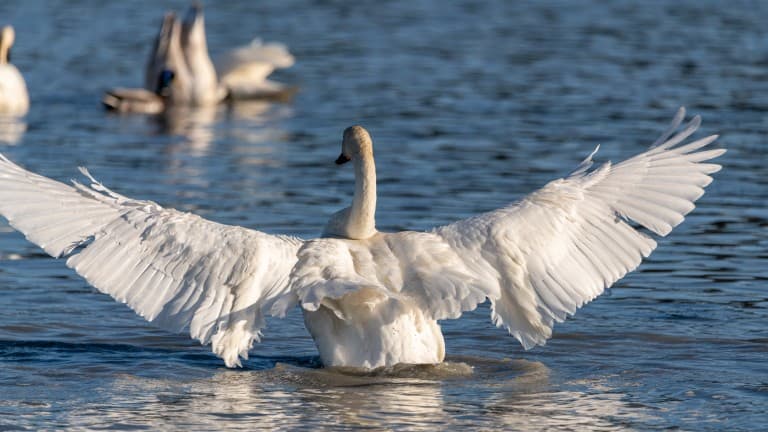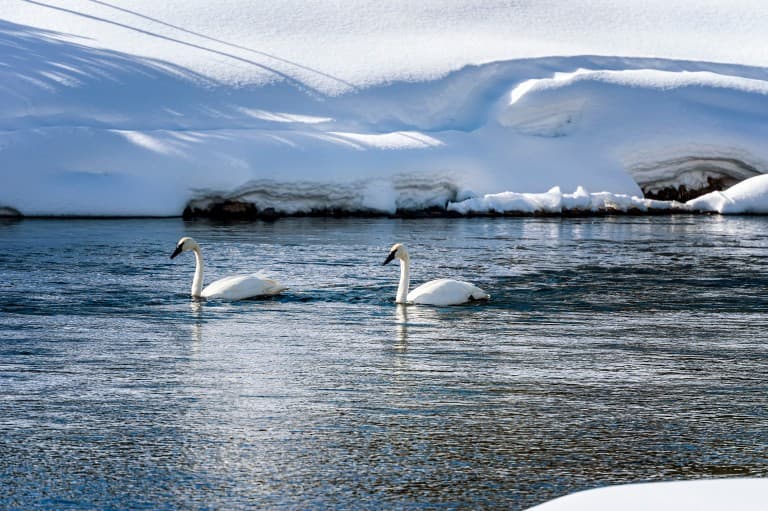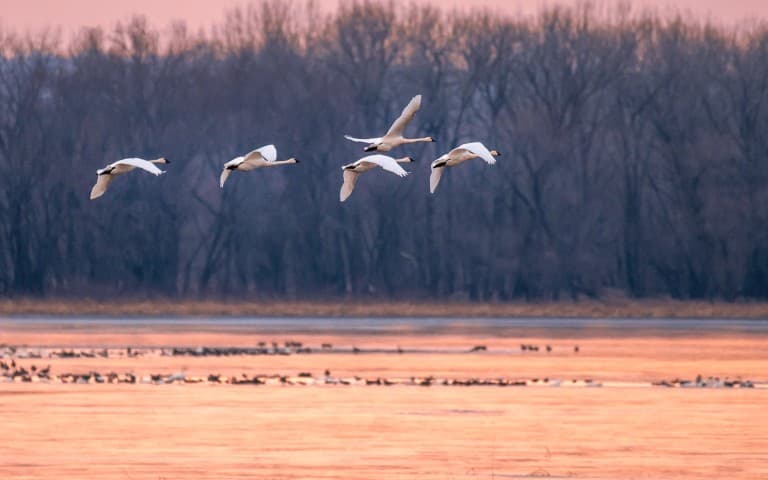Trumpeter Swan Profile
Of all the water birds, there’s nothing quite like a swan. Their unique vibrant appearance and elegant long necks make them outstanding among the smaller ducks and geese, and their progression from ugly ducklings to symbol of love and grace are a testament to persistence.
They’re also big. Very big. And the largest of them all is the Trumpeter swan, perhaps unsurprisingly found in North America.

Trumpeter Swan Facts Overview
| Habitat: | Wetlands and marine |
| Location: | North America |
| Lifespan: | 33 in captivity, 24 in the wild |
| Size: | 2.4m (7.9ft) wingspan |
| Weight: | Up to 13kg (28lb) |
| Colour: | White |
| Diet: | Plants and algae, sometimes insects |
| Predators: | Foxes, racoons, bears, wolves, mountain lions |
| Top Speed: | Possibly up to 155kph (96mph) |
| No. of Species: | 1 |
| Conservation Status: | Least Concern |
Trumpeter swans are enormous and intimidating, but they aren’t equipped to cause a human any damage despite the myths.
They breed in lakes, slow rivers, ponds and marshlands of northwestern and central North America, where they diet on aquatic plants, roots, tubers and the occasional insect.
They’re remarkable animals having been hunted to near extinction, and are capable of impressive flight speeds, a wide range of insults, and strong pair bonds.
Interesting Trumpeter Swan Facts
1. They’re one of the largest flying birds in the world
The trumpeter swan is the largest species of waterfowl, and both the heaviest and longest native bird of North America.
Their wingspan can measure up to 2.4 m (7.9 ft) and they can weigh over 15 kg (33 lb).
The sheer size of these birds means that other than human hunters, not much will take them on, and they live in relative peace with few predators.
In terms of average mass, they might be the heaviest flying bird in the world. For this reason, they made our Top 10 Largest Flying Birds in The World.

2. They were hunted to near extinction
In the 19th and early 20th centuries, the trumpeter swan was hunted heavily for game, and meat, as well as its feathers for quills.
The Hudson’s Bay Company killed thousands of swans each year in the late 1800’s. They were hunted to the point of extinction, with just 70 trumpeters reported alive in the wild in the US in 1933.
However, aerial surveys revealed a Pacific colony of several thousand trumpeters near Alaska’s Copper River. This population provided critical genetic stock to complement the small number still alive in the US across the states of Montana, Idaho and Wyoming.
Careful reintroductions by wildlife agencies and the Trumpeter Swan Society progressively increased the wild population in North America to over 46,000 birds by 2010.
3. They’re not dangerous
Let’s get this out of the way, because swans and geese have by no means earned their reputation as ferocious killers.
Perhaps a frozen swan, thrown through the windscreen of a moving car, could cause some injury. But of their own volition, swans have neither the bite force nor the body mass to do any harm to a person whatsoever.
Even if you steal their eggs, even if you pick up their babies, even if you call them a big-nosed turkey, a swan cannot cause any serious injury. These are flying birds with hollow bones, so if any arm is going to break, it would be theirs.
They have no talons and no sharp beaks, no bite force, and they’re not very handy with a knife. Now that we’ve got that sorted, let’s take a look at what they can do.

4. They can strike fear into the hearts of their human neighbours
These are large birds, and, like geese, they rely on intimidation to get what they want. Whether it’s your sandwich or your vacancy from the area, they can rise up, hiss, and peck at you to make it very clear that you’re not welcome.
They’re able to raise their wings and curve their neck in an impressive threat display, and the sound they make does resemble a prehistoric reptile.
This doesn’t happen often, and they will usually ignore or flee from people unless they’re defending a nest.
Still, the swan’s success relies entirely on the victim falling for its bluff.
People have been tipped out of canoes, fallen into lakes, broken bones, lost teeth, and any number of other horrible things that can happen when a person panics for no good reason; none of these things is ever a direct consequence of the attack.
They do have serrated beaks, which are capable of scuffing up the skin a bit, though this is the extent of the damage they can cause, and is not nearly as unpleasant as a paper cut.
5. They can talk
While the babies, or cygnets, mostly only say one thing (give me food), adults have a wider range of vocalisations. They also produce non-vocal communication sounds.
Cygnets use classic baby communication tactics known as screams and ‘waahs’. The scream is a demand for attention and the waah is a sign of surprise. They also have location calls and a sort of ‘everything’s ok’ alarm that they cheep with when they’re content.
The adults, on the other hand, have more to say. Trumpeter swans are named for their trumpeting alarm call, which warns the family that there’s a dog walker who needs his butt nipped.
Sometimes a pair of adults will alternate trumpets before sliding into a duet. This is thought to improve bonding and perhaps synchronise an attack.
A honk is issued as a precursor to a trumpet and signifies a lower level of immediacy in the alarm. This may or may not be followed by a foot clap, which is another form of intimidation or threat tactic.
Sometimes a wail is heard, the purpose of which is unclear, and then there are at least three other ways to express alarm, including hissing, trilling and something called a ‘Nor’.
Essentially, the swan has a complex and varied vocabulary to tell in exactly how they want you to get lost. 1

6. They can fly up to speeds of 155 kph
This is not unheard of in birds, but it is unusual in birds of this size and weight. By the time they’re around 3 months old, they’re about ready to get into the air, and they do so a lot like a seaplane: with a long runup and the consequent splashdown. 2
Trumpeter swans are the largest of all the waterfowl and aren’t far from the heaviest flying birds. As such, they’re not exactly Olympians, but they do manage to cover some distance. It’s said they can fly up to 1000km, but much more commonly prefer shorter trips of around 25 to 160 km.
But more impressively, once they’re up there, they have been clocked at speeds of somewhere between 135 and 155 km/h!
They’ll typically breed in the Northwest and migrate South as it begins to get cold but some populations stay a lot closer to home. 3
7. They can maintain a healthy relationship
One of the reasons they’re so symbolic of romance is their ability to make a heart shape by combining their neck with that of their partner.
But another reason is that this partner will likely be the one they stay with for life.
The courtship ritual is quite an impressive routine of head bobbing and wing flapping, and while the pair won’t always spend the entire year together, they’ll reunite with one another when it’s time to get the job done.
Both parents team up to build the nest and will guard the eggs and the subsequent chicks that emerge from them a month later.
Chicks are already pretty badass, but they’re ugly and small, and therefore at risk of bullying or predation, hence the fantastic illusion of danger from the adult swan. 4

Trumpeter Swan Fact-File Summary
Scientific Classification
| Kingdom: | Animalia |
| Phylum: | Chordata |
| Class: | Aves |
| Order: | Anseriformes |
| Family: | Anatidae |
| Genus: | Cygnus |
| Species: | Cygnus Buccinator |
Fact Sources & References
- Maureen Patton-Gross (1992), “Acoustic communication of the trumpeter swan (Cygnus buccinator)”, University of Wisconsin Milwaukee.
- (2023), “Trumpeter Swan Migration: A Complete Guide”, Birdfact.
- Jonathan Bart (2007), “Detection ratios on winter surveys of Rocky Mountain Trumpeter Swans Cygnus buccinator”, Wildfowl.
- Kaitlyn Robins, “Cygnus buccinator trumpeter swan”, Animal Diversity Web.
